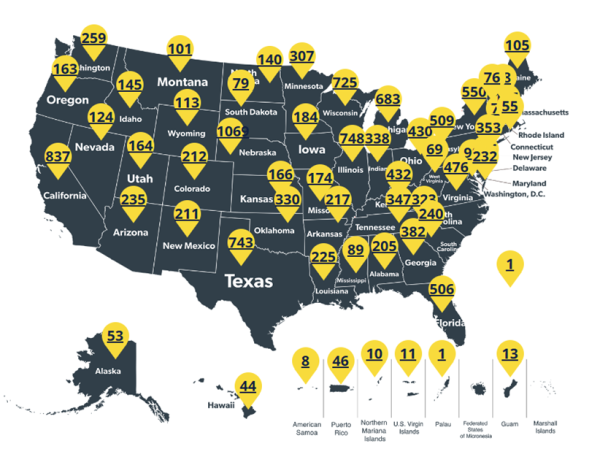WCER Team Creates National Platform for More and Better Jobs for People with Disabilities
Project getting big buy-in from states, practitioners, other partners
October 14, 2025 | By Karen Rivedal, Office of Research & Scholarship

This graphic shows the project has built more than 15,000 member accounts, with a presence in every U.S. state and territory.
A nationwide UW–Madison research project to increase the number and quality of jobs for individuals with disabilities has achieved an extraordinary record of reach and engagement with essential state workers tasked with helping this underserved population.
As the five-year, federally funded project known as the Vocational Rehabilitation Technical Assistance Center for Quality Employment (VRTAC-QE) begins wrapping up, electronic records leave little doubt the $16.7 million initiative hosted by the School of Education’s Wisconsin Center for Education Research (WCER) is reaching its intended target.
On the project website, created to funnel targeted training and practical tools at no cost to state vocational rehabilitation agencies trying to better serve people with disabilities, server logs show:
- Website visits totaling 1.1 million.
- 15,081 total active website members.
- Visitors from all U.S. states and territories.
“These numbers tell a story of collaboration, commitment, and impact,” said principal investigator (PI) Timothy Tansey. “They show how evidence-based tools, accessible resources, and strong partnerships can strengthen the work of vocational rehabilitation professionals and improve outcomes for people with disabilities.”
The VRTAC-QE site is one of several projects of the Innovative Partnership for Advancing Rehabilitation Research and Training, or IPARRT, a WCER-based research team focused on fostering breakthroughs in rehabilitation counseling research and practice.
In keeping with that goal, the comprehensive assistance provided by VRTAC-QE isn’t just meant for state administrators and counselors. The initiative developed interactive resources to build the knowledge and skills of three additional audiences: community service providers that partner with the state agencies to serve people with disabilities, employers and potential employers of individuals with disabilities, and military veterans.
What’s more, the VRTAC-QE website is designed to remain free and publicly accessible past the project’s official end in January 2026. The research team intends it to be a sustainable national platform for anyone concerned with meaningful jobs and careers for individuals with disabilities—with a focus on competitive, integrated employment—including state agencies, community providers, people with disabilities, employers, researchers, educators, and policymakers.
Quantifying the Challenge and Response
At least 1.2 million people with disabilities receive support and counseling annually from state vocational rehabilitation agencies to find or keep jobs, but room for improvement exists in services and job outcomes. The most recent U.S. Department of Labor statistics illuminate the challenge—and opportunity—provided by the disabled population.
While 67.9% of individuals aged 16 to 64 without a disability were employed in 2025, only 25.1% of people with a disability had jobs. Unemployment rates for individuals with disabilities were also double that of people without disabilities, or 8.6% compared to 4.3%.
A detailed Impact Snapshot created by the IPARRT team describes measures of reach and engagement, including the most visited individual pages of the VRTAC-QE website:
- Member Login: 115,088 visits.
- Member Dashboard: 77,111 visits.
- Home Page: 75,191 visits.
- Training Home Page: 65,783 visits.
“Our website has been a central hub for vocational rehabilitation professionals across the country,” said Tansey. “Each number represents more than just data—it reflects real connections, valuable learning, and lasting change. Our focus has remained steady: support professionals, strengthen practices, and share what works.”

Project PI Timothy Tansey led the five-year, $16.7 million project to help states create more jobs and meaningful careers for people with disabilities.
The mountain of rich resources created by the project and available on the website include 14 outreach guides, 17 resource guides, 29 fact sheets, 27 research summaries, and four peer-reviewed journal articles sharing project findings. Live webinars by recognized experts also are presented every month on the website, with an archive of 44 available, and a total of 66 quality employment trainings, from “Ag Workers with Disabilities” and “Anxiety Disorders” to “Strategies for Working with Chambers of Commerce” and “Work Centrality.”
“From quick charts to comprehensive guides, the project created practical tools you can use right away,” Tansey said. “Whether you’re planning services, engaging employers, or strengthening outreach, these resources are designed to save time and spark ideas.”
Many resources are highly specialized, with an overall outreach guide but also separate guides for reaching people with disabilities in different populations, such as rural communities, Native Americans, Hispanics, military veterans, African Americans, and justice-involved people, including individuals who have been incarcerated, are on parole or under probation. Similarly, resource guides cover many topics, such as a review of three key laws protecting students with disabilities, motivational interviewing, remote communication, customized employment, work-based learning, and employer support and engagement.
Project records show a total of 283 trainings provided through the website, in webinars on varied subjects involving quality employment, including artificial intelligence, transportation issues, and strategies to support people with specific disabilities. On-demand training also is available, along with a slate of educational events, for a total of 52,896 training participants.
The IPARRT team also organized three national symposiums, with 7,495 total attendees and 202 total speakers, in 2023, 2024 and 2025.
The website keeps track of interactions that reflect real-world use, such as:
- A total of 112,326 total resource downloads.
- 2,852 views of the team’s white paper.
- 5,260 downloads and 1,555 views of implementation toolkits.
- List of the three most downloaded implementation toolkits, identified as an outreach guide, a career pathways toolkit, and a business relations blueprint.
The Impact Snapshot “shows how the grant has met the project goals in terms of reach, engagement and resources for state agencies,” said project manager Stacie Castillo.
“We built the website from scratch,” she added. “So, to have over 15,000 members and over a million visits, we’re very proud. It is a great resource for vocational rehabilitation agencies and their staff and their community partners.”
National Collaborations Power Project
The project team assembled its resources and other materials in large part through collaborations with national leaders in research and training experienced in identifying and sharing innovative employment practices for people with disabilities. The collaboration list includes seven universities: Florida Atlantic, South Carolina State, UW–Stout, Illinois at Urbana-Champaign, Kentucky, Texas at El Paso, and Virginia Commonwealth.
In addition, three organizations, Autism Workforce, Employment Resources, Inc., and the Council of State Administrators of Vocational Rehabilitation, are project partners, along with a community platform known as yolBe or “Your Life Only Better,” for building social capital, skills and careers. UW–Madison’s own areas of expertise in quality employment for people with disabilities were cited as outreach to Native Americans, STEM career pathways, business engagement, transportation, health and disability, and justice-involved individuals.
Early on, the IPARRT team also compiled a comprehensive white paper to guide the overall project, including a needs assessment, a collection of existing research and best practices, and a detailed review of what worked and what didn’t at each state agency.
While most reports, research summaries and other resources are available to explore on the website with a click, enrolling in a free membership provides additional online benefits, including the ability to join in conversations, save favorited content for later viewing and learn about available training opportunities by interest area at a given location.

The project’s website has seen more than 112,000 resource downloads and provided training to over 52,000 people.
As a federally funded project, the VRTAC-QE was responsible for demonstrating performance across multiple performance measures, all consistent with the project’s mission to increase both the number and quality of employment outcomes for individuals with disabilities by equipping state vocational rehabilitation agency personnel with cutting-edge knowledge, skills and resources. Among others, these measures included demonstrating that the training and technical assistance provided was rated by participants as high in quality, relevant, and useful; that VRTAC-QE services resulted in increased coordination and collaboration between the state vocational rehabilitation agencies and federal, state and local organizations; and that state vocational rehabilitation agencies that received training and technical assistance saw a positive change in consumers achieving an employment outcome annually. Although data collection and analysis are ongoing, and the final project evaluation is not yet completed, the project has consistently demonstrated progress across measures.
In addition to Tansey and Castillo, the UW–Madison IPARRT team for the VRTAC-QE project includes co-PI Malachy Bishop; researchers Emily Brinck, Cayte Anderson, Chelsea Brehmer, Jessica Holton, and Karin Grandon; faculty from the School of Education’s Department of Rehabilitation Psychology and Special Education—David Rosenthal and Jina Chun; and project assistants Natalie Meyer and Jeff Meyer.
The federal grant for the project was awarded by the U.S. Department of Education’s Rehabilitation Services Administration, with an original end date of Sept. 30, 2025. A no-cost extension received by the project team ensures continuing support for the website, with the project’s monthly webinars continuing through at least Jan. 31, 2026.
**********
About IPARRT
Its mission is to catalyze collaboration among researchers, practitioners, educators, and policymakers to address the multifaceted challenges faced by individuals with disabilities and promote their full participation and inclusion in society. For more, visit iparrt.org.
About the Wisconsin Center for Education Research
The Wisconsin Center for Education Research at UW–Madison’s #1 ranked public School of Education is one of the first and most productive education research centers in the world. It has assisted scholars and practitioners in developing, submitting, conducting and sharing grant-funded education research for over 60 years.
WCER’s mission is to improve educational outcomes for diverse student populations, positively impact education practice and foster collaboration among academic disciplines and practitioners. Learn more at wcer.wisc.edu.


